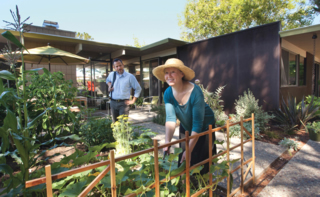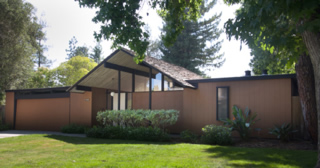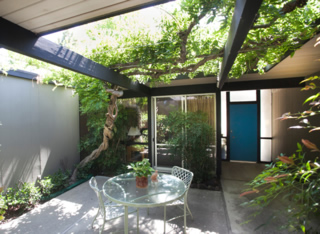Intellectual Paradise - Page 3
For Eichler, though, any degree of customization represented a change in procedure. As longtime Eichler saleswoman Catherine Munson has said, “We would hardly let anybody choose anything at all.”
Not so on campus, however, where Eichler, retaining his well-known “gruff” manner, according to client Christiane Andreopoulos, was willing to change his designs to meet client requests.
 |
|
|
Andreopoulos, a French woman, whose husband Spyros, a Greek, came to Stanford in 1963 as administrative director of communications for the hospital and medical school, remembers approaching Eichler at his Fallen Leaf Park subdivision in Los Altos, inquiring about a home for their lot on campus.
“Not much social grace,” she recalls. “He was direct, which is fine.
“I would like to see one of your houses. I don't know about them,” she told Eichler. Joe replied, “Well, if you don't know about them, why would you want to have one?”
“It was not the nicest introduction at first. Most people are sort of lovey-dovey, but not he.”
Still, when Andreopoulos suggested that significant changes be made in the plan—like eliminating the family room behind the kitchen, replacing it with a covered patio that occupied the same footprint—Eichler said yes.
 |
|
|
The result, she said, is her favorite area of the house, filled with light, a place she graded papers when she taught at a private school. “I feel like I'm outside without being in the wind,” she says. And the covered patio gave her daughter a sheltered spot for outdoor play.
The Andreopoulos home remains a marvelous place today, still mostly original, its atrium filled with a wisteria vine planted at the suggestion of her daughter when she was a child. (The daughter has since become a landscape designer.)
Andreopoulos still marvels at the movement and play of light, “the feeling of being protected from the wind and dust, and whatever falls down from the sky.”
“See the leaves? It's alive. It isn't something that is static.”
Unlike many residential sections of the campus, her cul-de-sac is well stocked with Eichlers—five. The owners feel a certain kinship, she acknowledges. “It's like when you come from Europe,” she says, “you have a kinship when you meet a compatriot.”
 |
|
|
Canadians Ronald McKinnon, an international economist (one of his books is The Order of Economic Liberalization: Financial Control in the Transition to a Market Economy), and Margaret McKinnon, a writer and editor formerly for Sunset, settled into a Palo Alto Eichler when he arrived at Stanford in 1961.
But they wanted to live on campus. So they leased a lot and got a mailing from Eichler offering his services.
“I called him and said we had a problem site, a slope. Eichlers wouldn't work. So I'm going to hire an architect,” Margaret recalls.
“He said, ‘Lady, you'll find out that doesn't work. You'll come back to me later.'”
As it turns out, working with the architect proved a “disastrous exercise,” as costs mounted and the architect's proposed solutions did not please. So the McKinnons found themselves visiting model homes at Fallen Leaf Park.
“Whenever we went, Eichler would be sitting in the garage with an open door,” Margaret remembers. “He'd be buffing his nails and reading the New Yorker and smoking a cigar.”




